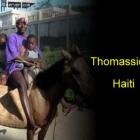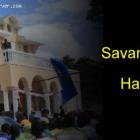ADVERTISEMENT
Charcoal - Haiti Observer Blog
Charcoal, Haiti Observer Blog. Read the following articles about Charcoal
Charcoal: Haiti's Dark Enemy
In Haiti, Drought is usually believed as a natural disaster beyond human control. But as researchers carefully look into the earth's changing bio climate, and the symbiotic relationships between livings organisms and climatic forces - They come to realize the crucial role of Deforestation.
For decades, we've been ecologically destructed our own habitat in the pursuit of financial stability without reminding the consequences of our mass destructively demolition. No mistake about it, deforestation brings lots of unexpected effects on our own Soil and results in many consequences.
Deforestation also leads to soil erosion, floods, climate change, health issues, ecological degradation, biodiversity, and wildlife extinction, and lastly community devastation to name a few. Even though, all of these actual facts are scientifically proven to be true, Haitians seem to be careless, selfish, and even ignorant about the problematics/consequences. Instead, they cut down massively the forestall trees to make Charcoal as the primary source of fuel consumption for cooking. Consequently, Haiti remains still one of the most deforested nations in the western hemisphere.
The Beautiful town of Boucan-Carre in Centre Department
Boucan-Carré, a district part of the Mirebalais Arrondissement, situates itself within the Centre Department of Haiti. Duffailly, Petite Montagne, and Les Bayes comprise the communes of Boucan-Carré.
Boucan-Carré's terrain is a combination of high mountain peaks and steep hollows. The Boucan-Carré River streams through the center of Chambeau, a small town. Agricultural farmlands dot the area and the charcoal industry is a chief means of employment for many residents.
More beautiful pictures about Boucan Carre in Haiti
Many non-government organizations have come forward to help strengthen Boucan-Carré's infrastructure. Since the early 2000's, U.S.-based NGOs, Haiti Outreach Program, Give Haiti Hope, and Partners in Health, have supported infrastructure development and maintenance. One of its projects, a full-service medical facility, has evolved from a local community clinic.
Fort-Liberte In The Nord Department Of Haiti
Fort-Liberté is located in Haiti's Nord-Est-Department. In Haiti, it is the oldest country and Haiti got its independence here on November 29,1803. The Dominican Republic is located close to its border. Around 11,465 people inhabit the place. The language spoken in the region is Creole. Hurricanes, storms and sunshine are all experienced bringing changes in temperature.
How It Got Its Name
Indians inhabited the region originally after which the Spanish colonists came. In 1578 they found the city of Bayaja and in 1605 abandoned it. In 1732 the French reoccupied it as Fort-Dauphin. In 1764, Spanish forces captured it and in 1801 shortly, after independence was declared in 1803, it was restored to the French.
As source Kaara decreases, Saut d'Eau may no longer exist
Saut-d'Eau falls in the Central Plateau of Haiti is at peril of running dry. Its mouth, Kaara, is not producing enough water to keep the waterfall of Saut-d'Eau at full volume, having declined in its output over the last six months.
Simon Desras, President of the Senate, worries if the falls should stop flowing, the economy of the Central Plateau will suffer. The stoppage would damage, not only the economy of the region, but affect a tradition that has taken place at the falls since 1847. In that year, an apparition of the Virgin Mary manifested at the twin falls, beginning an annual pilgrimage to Saut-d'Eau, to bathe beneath the onrushing streams that plunge down the gorge. Upwards of 20,000 bathers visit each year for this sacred rite.
The Town of Cornillon and its environment
There are many things and factors that contribute to the current condition in Cornillon, a small town in the Arrondissement of Croix-des-Bouquets. It is not a super rich town but its people still have a decent source of livelihood. To know more about the town in the Department of Ouest, here are some more information about it.
Situated in a mountainous region of the southern eastern part of the country, Cornillon has more than 48,900 inhabitants. The town comprises of five sections and witnesses tropical wet and dry weathers.
The town has experienced wide deforestation. This is because settlements were needed. Deforestation was also done in order to give way for more charcoal production. Such production is one of the main sources of income in the town because the demand for coal is high across the country. Because charcoal is the primary source of fuel in Haiti, charcoal product has become one of the highest income-generating livelihoods, especially in Cornillon. However, people do not only rely on charcoal production to make ends meet. They also produce fruits and coffee. Without agricultural and charcoal productions, residents will probably find it more difficult to get by as the town is not as wealthy as the other cities in the country.
Mombin-Crochu and Living condition
Many people in the town of Mombin-Crochu in the Vallieres Arrondissement live in poverty. Residents do not have the luxury of living a very comfortable life, as Mombin-Crochu is one of the poor towns in the country. In fact, children are forced to walk barefoot because they do not have money to buy slippers. They also walk just to go to school because only a few have access to donkeys, which are the main transportation in the town.
When it comes to utilities, residents in Mombin-Crochu have to go by without a regular supply of water and electricity because they could not afford it. In order to make fuel and cook, they use charcoal and wood fire.
Plaisance, A Favorite Sightsseing Destination In Haiti
Plaisance is located in Haiti's Nord Department. In the Plaisance Arrondissement, it is a municipality. Around 63,278 people inhabit the place as indicated by the 2009 estimates. During the colonial times, the French considered Plaisance a favorite destination for relaxation and rest.
Sightseeing
Located nearby, is a peak called Morne Bedoret at a height of 543 meters. The Fort Bedourete is located here. There are a large number of sites and monuments to see in Plaisance. They include Miracles Virgin Gobert's former chapel where in 1803, Alexandre Petion and Jean-Jacques Dessalines met before the launch of the final assault against Cape Francais.
Briquettes, an alternative to charcoal in Haiti
Due to lack of alternative in Haiti, charcoal has become the mean for cooking for the majority of the people. Unfortunately the demand for charcoal has destroyed the environment to the point of leaving Haiti in a state of emergency.
One group is determined to change this behavior by manufacturing briquettes for cooking made of trash. Even more importantly is that this process is made possible by using something that Haiti already has too much of, trash.
The recycling process turns the neighborhood's trash into cooking fuel. This has created jobs for many already and will likely create even more.
Our objective is to share with you news and information about Haiti and the people of Haiti. Traditions, habits and the way we were or grew are alive in this site. We highly recommend that you Subscribe to our Newsletter and also share with us some of the things that are memorable and made us unique people.

 Black Friday Shopping Season
Black Friday Shopping Season  Haitians are a Proud People
Haitians are a Proud People  Thomassique, Haiti
Thomassique, Haiti  The Town of Savanette, Haiti
The Town of Savanette, Haiti  Newsletter
Newsletter